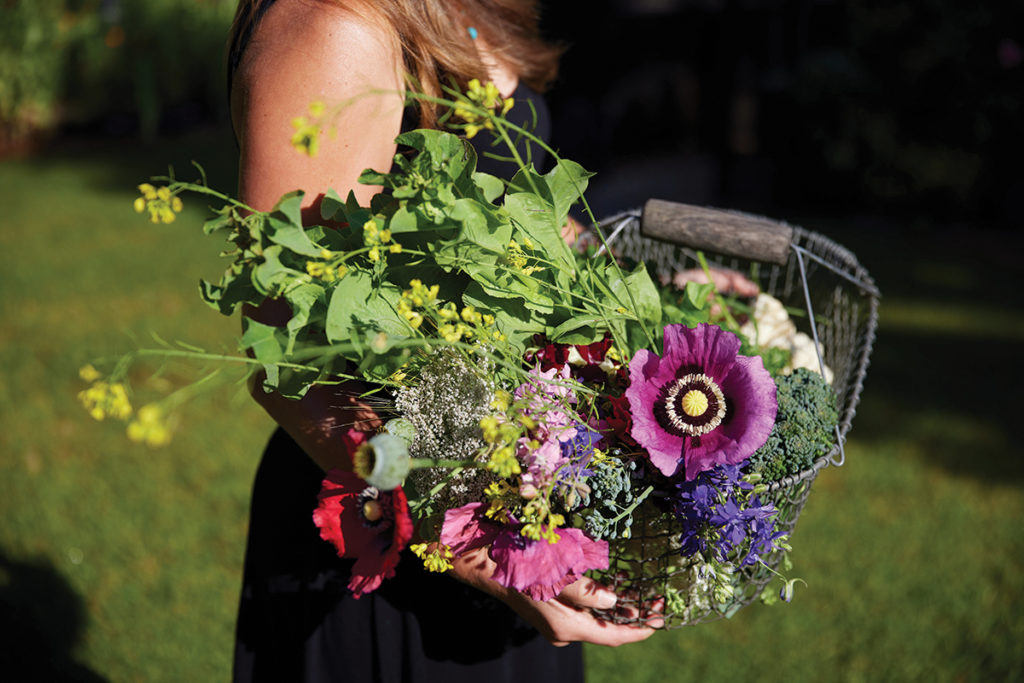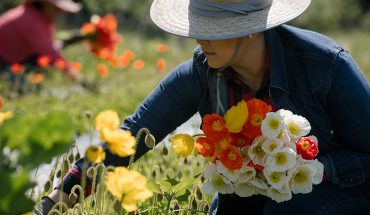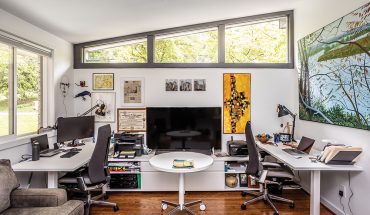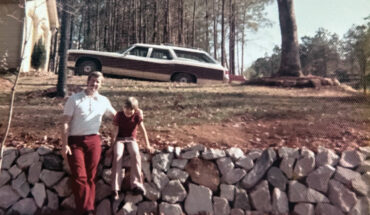This Triangle horticulturist is changing the way suburban homeowners grow fruits and vegetables with her unique approach to gardening.
by Miranda Evon | photography by Samantha Everette
Hidden in a quaint neighborhood just off Main Street in Fuquay-Varina is horticulturist Brie Arthur’s home. It’s painted a deep blue, dressed in black shutters and wooden shingles, with crisp white trim. But the first thing you notice is what surrounds the house: it’s edged on all sides with poppies and larkspur. Mature oak trees shade her wide lawn, and nut and fruit trees welcome visitors at the entrance of the driveway. “It’s definitely a cottage style; every crevice has something bursting into bloom,” she laughs.
“You can feel her energy in the garden,” says friend and fellow horticulturalist Preston Montague. “It’s exuberant, it’s bubbly and colorful, and no square inch is untouched.” And if you look a little closer, you might notice surprises in there: red pops of ripe tomatoes, white globes atop green garlic stalks, and curly leaves of mustard greens and kale. There are spiky heads of barley and fluffy blueberry bushes, the fruit still in flower.
“For me, it’s not either gardening for pleasure or gardening for food — you can do both,” says Arthur. “I want to convince suburban homeowners that they can use their existing landscape to grow vegetables, fruits and herbs.” Arthur is a pioneer in the practice of “foodscaping,” which means incorporating fruits, vegetables and herbs into a garden alongside ornamental plants. “I want people to understand that you don’t have to be a farmer to grow food in a meaningful way,” she says.
Arthur grew up in southeastern Michigan and discovered home gardening through 4-H. She went on to study landscape design and horticulture at Purdue University. After college she worked in ornamental plant production at Plant Delights and Camellia Forest in Raleigh. In 2005, she bought a home in Fuquay-Varina “because it was cheaper to buy than to rent with two cats and a dog!”
Still, her costs were high, and fresh produce was a splurge. “I realized I could save money by growing my own,” says Arthur, “and I thought, I have a degree in horticulture, I should know how to raise plants.” She started the way many folks do, with rows of veggies in raised beds — but her HOA fined her for the “hideous” crops in her front yard. “They were crazy strict, but I also didn’t want my neighbors to hate me,” she says. “I had to find a better way to grow produce in plain sight.”
So Arthur planted fruits and vegetables within her ornamental beds: peppers, kale, strawberries, lettuce and corn right next to her colorful seasonal flowers, all around the front of her house. No one complained (her subdivision even awarded her the “yard of the year” once). And it made her question why home gardeners tend to approach growing crops the way farmers do. “I’m a human, not a tractor — I don’t need to plant things in straight lines,” she laughs, “plus, there’s no artistry to it.”
By the time Arthur moved into her current home with her husband David in 2011, it was a given that foodscaping would be part of the landscape. Each area on this acre of land is accounted for. In late May and early June the garden is her “poppy haven,” but grains like wheat, oats and barley are at their peak, too. The spring lettuces are mostly done, but strawberries are still in bloom, and onion and garlic grow year-round on the edges of the garden. Sweet potatoes, broccoli and cauliflower come in autumn. “I don’t think that people realize the intricacy with which she’s woven food plants into the garden; that’s one of her core innovations,” says Montague.
And all of these things find their way into the kitchen. “We’re huge ratatouille people — in June we get the early tomatoes, squash and zucchinis, and the basil is just becoming something we can harvest regularly,” Arthur says. She estimates that she and her husband make about 70% of their meals with picks from their backyard. “Whenever I visit Brie, she does the cooking, and we’re always eating seasonally. It’s often simple but it’s fresh so it tastes amazing,” says Montague.
In 2014, Arthur started her own brand, becoming an educator on the benefits of home gardening. She now speaks nationwide on the subject, and has written two bestselling books: Gardening with Grains and The Foodscape Revolution. “Foodscaping allows you to be creative with how you grow your own produce,” says Arthur. “I want to show people of all income levels the opportunity you have while living in the suburbs.” Part of that involves getting people to think about what produce they frequently buy. “If week-to-week you’re buying garlic, onions, potatoes and herbs, plant those!” she says. “And use your existing beds, don’t waste the effort and money tearing out sod to create a new area.”
Another big benefit Arthur found in mixing her crops with ornamental plants is that the two help each other grow. “Instead of creating a monoculture, there’s biodiversity. The ornamentals attract pollinators, but spicy foliage like mustard and arugula deters critters like rabbits and groundhogs,” she says. When you foodscape, you naturally rotate your crops, and diseases and pests don’t spread as easily. Arthur uses buckwheat, carrots and crimson clover as cover crops, which cuts down on the weeding. “When you put veggies in beds, you recognize just how delicate and insect-prone fruiting plants are — if you eat them, insects will, too!” says Montague. “But if they’re planted in with other plants, they’re more protected from pests, deer and their own mechanical failures.”
Arthur regularly invites friends, family and guests to her garden. She hosts twice-annual open garden days for hundreds of people and private sip-and-strolls through local garden clubs. Neighborhood kids are welcome to pick strawberries (“Anything they miss gets turned into daiquiris!” she says) and next season, there will be tomato tastings of the more than 100 varieties on her property. (Though, she says, she wishes tomatoes weren’t the “gateway” crop for many home gardeners: “They are so vulnerable to disease around here, they’ll make you question why you’re alive. Grow garlic instead!”)
And Arthur and her husband are currently developing the property next door as an immersive rental experience with a gardening and culinary component. “We’ll do a cooking demo with dinner, make cocktails from the plants on the patio — it’ll be hands-on, to really understand the foodscaping mentality,” she says.
As one season comes to an end, with another on the horizon, the couple continues to celebrate the fresh arrival of produce — and to share the journey with others. “The point is not to never step foot into a grocery store again, just to start with a few things to realize how cool it is to grow your own food,” she says.
__
This article originally appeared in the June 2022 issue of WALTER magazine.








